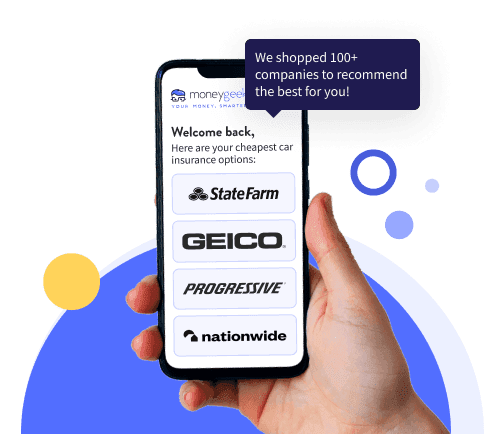Transferring insurance to a new car is simple. Call your insurer or update your policy online, providing details like the VIN, make, model and year. Since premiums depend on your vehicle's value and type, you'll need a new quote. Use this opportunity to reevaluate your coverage options. If your new car is more valuable, consider increasing your limits to avoid out-of-pocket repair costs.
How to Transfer Car Insurance to a New Car: Step-by-Step Guide
To transfer car insurance to a new car, contact your insurer with details about the vehicle. Provide the required documents to update your policy quickly.
Find out if you're overpaying for car insurance below.

Updated: July 3, 2025
Advertising & Editorial Disclosure
Key Takeaways
You can transfer your existing car insurance to a new vehicle without opening a new policy, saving time and avoiding coverage gaps.
Your rates may change based on your new car's value, safety features and theft risk. There's usually no transfer fee.
You have seven to 30 days to update your policy, depending on your insurer, though it's best to call before driving off the lot.
Compare Auto Insurance Rates
Ensure you're getting the best rate for your auto insurance. Compare quotes from the top insurance companies.
How to Transfer Car Insurance to a New Car in Five Steps
- 1
Gather Required Information Before You Call
Have this information ready for your insurer:
- Vehicle Identification Number (VIN)
- Make, model and year
- Purchase price or current value
- Safety features (anti-theft systems, airbags, etc.)
- Your new car's primary use (commuting, pleasure, business)
- Names of all household members who'll drive the car
- 2
Contact Your Insurer
Call your insurance company or update your policy online if available. Many insurers offer 24/7 customer service for policy changes. When you call, provide your policy number and share your new vehicle details. Discuss any coverage changes you want to make, such as adjusting deductibles or adding new coverage.
- 3
Reassess Your Coverage Needs
Review whether your current financial protection still makes sense. Learn how much car insurance you need based on your new vehicle's value and your financial situation. If your new car is financed or leased, you'll need comprehensive and collision coverage — it's not optional. Consider increasing your liability limits for more expensive vehicles since higher-value cars often mean higher repair costs and potential lawsuit settlements. If there's still a loan balance on your new car, ask about gap insurance to cover the difference between your car's actual cash value and what you still owe.
- 4
Get Your Updated Quote
Your insurer will calculate your new premium by evaluating several factors about your new vehicle. Use our car insurance calculator to estimate costs before you call. They'll consider your car's theft rates, safety ratings, repair costs and how these compare to your previous vehicle. Your driving record and where you park the car also influence the final rate. Don't be surprised if the quote differs significantly from your current premium. Newer cars often cost more to insure, but safety features and anti-theft devices can sometimes lower rates through car insurance discounts.
- 5
Finalize the Transfer
Once you approve the new rate, immediately get written confirmation of your updated policy. If your premium increases, ask about payment options. Many insurers let you spread the additional cost across the remaining policy months rather than paying upfront. Make sure you have proof of insurance before driving, and don't forget to remove your old car from the policy if you're not keeping it. This final step prevents you from paying for coverage on a car you no longer own.
What to Expect When You Transfer Your Auto Insurance?
Your car insurance rates typically change when you transfer coverage to a new car, but there's no fee for the transfer itself. Whether your premium goes up or down depends on several factors about your new vehicle.
Your rates increase when your new car:
- Is worth more than your previous vehicle
- Has a higher theft rate in insurance databases
- Lacks advanced safety features
- Requires more expensive repairs
Your rates may decrease if your new car:
- Has better safety ratings and features
- Is less expensive to repair
- Has lower theft rates
- Qualifies for new car discounts.
Most insurers don't charge a fee for transferring your policy to a new car, though leading car insurance companies vary in their grace periods and transfer requirements. If the rate increase is significant, you can shop around with other insurers before finalizing the transfer.
When to Transfer Insurance to a New Car?
You have three options when buying a new car, and choosing the right approach depends on your situation:
Replace Your Old Car (Most Common)
Transfer your existing policy from your old car to your new one. This works best when you're trading in or selling your current vehicle, want to keep the same insurer and your current coverage meets your new car's needs.
Add Your New Car to Your Policy
Keep both vehicles on the same policy. Choose this option when you're keeping your old car, want multi-car discounts, and both cars will be driven regularly.
Switch to a Different Insurer
Switch to a new insurance company and start fresh with better rates or coverage. Consider this when you find significantly better rates elsewhere, your current insurer doesn't offer the coverage you need, or you're unsatisfied with your current service.
MONEYGEEK DECISION TIP
If you're unsure, get quotes for both transferring with your current insurer and switching to a new one. Compare the total cost and coverage before deciding.
Common Mistakes to Avoid When Transferring Insurance
These mistakes are easy to make when you're excited about your new car, but they can be costly:
Don't Wait Until After You Buy
Mistake: Assuming you're automatically covered for 30 days
Reality: Grace periods vary by insurer (seven to 30 days), and some states require proof of insurance before registration
Solution: Call your insurer before finalizing your purchase, ideally while you're at the dealership. Check your state's minimum requirements before buying.
Don't Assume Your Coverage Is Adequate
Mistake: Keeping the same coverage limits for a more expensive car
Reality: Your liability limits should match your assets, and comprehensive/collision deductibles affect your out-of-pocket costs
Solution: Review your coverage needs each time you get a new car, especially if it's worth significantly more than your previous vehicle.
Don't Forget About Household Drivers
Mistake: Not adding new drivers or forgetting to update driver information
Reality: Most insurers require all household members to be listed, and unlisted drivers may not be covered
Solution: Learn about adding drivers to your insurance when household situations change.
Insurance Requirements for New Cars
The coverage you need depends on whether you own, finance or lease your car:
- If you own the car outright and aren't financing it, you can cover it with your state-required coverage.
- If you're financing your vehicle, your lender will likely require full coverage insurance. If your current policy includes only liability, update it to include collision and comprehensive insurance to avoid violating your loan agreement.
- If you're leasing a car, you must get your own coverage. Some lessors may require gap insurance.
The table below shows the most appropriate insurance type for each situation.
Required Coverage | Minimum Coverage | Comprehensive | Collision |
|---|---|---|---|
Financed vehicle | ✓ | ✓ | ✓ |
Leased vehicle | ✓ | ✓ | ✓ |
Owned vehicle | ✓ |
Car insurance laws vary by state, and minimum requirements differ depending on where you live. Most states require only minimum coverage; your insurance won't cover repair costs if your vehicle is damaged.
Consider increasing your coverage limits, especially if you’ve purchased a high-value vehicle. A full coverage policy with comprehensive and collision insurance may be a better choice to avoid large out-of-pocket expenses.
How Much Does It Cost to Transfer Car Insurance?
The average cost to insure a new car is $1,895 annually for full coverage, according to MoneyGeek's analysis of major insurers. However, your actual premium depends on your specific vehicle and situation.
Most insurers don't charge a fee for transferring your policy to a new car. You'll simply pay the difference between your old and new premiums. If your new rate is higher, insurers offer flexible payment options: you can pay the difference upfront, spread the additional cost across remaining policy months, or adjust your monthly payment going forward.
MONEYGEEK EXPERT TIP
If you find your premiums too expensive after getting an updated quote, you can always shop around for other policies.
Average Cost of Transferring Car Insurance
When estimating the cost of transferring car insurance, several factors play a role, including your car's make and model, coverage level, your location's risk level and any additional fees. The table below lets you adjust for your car's make, model, age and desired coverage to get an estimate.
Compare Car Insurance Quotes
Car insurance companies consider several factors when calculating premiums. Comparing rates helps you find the best policy for your needs. MoneyGeek's calculator provides personalized quotes from multiple providers based on basic information, giving you an accurate estimate of your car insurance costs.
Car Insurance Calculator
MoneyGeek's car insurance calculator will give you a customized estimate of your auto insurance cost. It's free to use, requires no personal information and we won't send you any spam.
Rates updated:
Jul 11, 2025
| Insurance Carrier | MoneyGeek ScoreMG Score | Average Monthly Payment | |
|---|---|---|---|
| 1 |  Capital Insurance Group | 94 /of 100 | $87 |
| 2 |  GEICO | 82 /of 100 | $109 |
| 3 | 83 /of 100 | $118 | |
| 4 | 83 /of 100 | $129 | |
| 5 | 79 /of 100 | $133 | |
| 6 | 77 /of 100 | $151 |
Your Next Step:
Get your real quotes from trusted insurance providers.
Although MoneyGeek partners with some of the companies we recommend, our content is written and reviewed by an independent team of writers, editors and licensed agents. Learn more about our editorial policies and expert editorial team.
How Long Do You Have to Transfer Insurance to a New Car?
While you have seven to 30 days to update your policy, consider rental car insurance if you need temporary coverage during the transfer process, but this varies by company:
Common Grace Periods by Insurer
Insurer | Grace Period |
|---|---|
GEICO | 30 days |
State Farm | 14 days for newly acquired vehicles |
Progressive | 30 days |
Allstate | 14 days |
USAA | 30 days (for military members) |
MONEYGEEK EXPERT TIP
Important: Don't rely on grace periods as your primary strategy. Some states require proof of insurance for registration, and you could face penalties for driving uninsured if you have an accident during the grace period.
Grace period disclaimer: Grace periods don't guarantee coverage if you have an accident. Contact your insurer immediately to avoid any gaps in financial protection.
Best practice: Contact your insurer before or immediately after purchasing your new car to avoid coverage gaps.
Compare Auto Insurance Rates
Ensure you're getting the best rate for your auto insurance. Compare quotes from the top insurance companies.
Transfer Auto Insurance to a New Car: Bottom Line
Transferring car insurance to a new car is straightforward, but timing and preparation make the difference between a smooth process and potential headaches. Contact your insurer with your new vehicle details, reassess your coverage needs and get written confirmation before driving.
If your rates increase significantly, don't hesitate to shop around with cheaper car insurance companies. You might find better coverage at a lower price with a different insurer. The key is ensuring you never drive without proper financial protection, even for a single day.
Transferring Insurance to a New Vehicle: FAQ
You can transfer insurance from one car to another when you buy a new vehicle. Here are the most common questions about how this process works.
Is it possible to transfer car insurance to a new car?
You can transfer insurance from your old car to your new one. Typically, a call to your insurance agent to inform them of your purchase is all it takes to start the process. Some insurers even allow you to update the vehicle on your policy online.
How much will it cost to transfer insurance to a new car?
The cost of transferring insurance to a new car varies by insurer. The following may contribute to your expenses:
- Higher rates for a newer vehicle
- Expanding your coverage to include comprehensive and collision insurance
- Increasing coverage limits in anticipation of more expensive repairs
- Administrative fees for processing the transfer
Getting new car insurance often indicates having different coverage needs. In addition to processing fees, consider how much it costs to insure a new car.
How long is the grace period for getting car insurance for a new car?
Insurers give different grace periods to get coverage for your new vehicle, usually between seven and 30 days. Contact your insurer directly to find out how much time you have.
Do I have to insure all my cars with the same company?
No, but for convenience, you can insure up to four cars with the same company under one policy. However, if you’re insuring a classic car, you must enroll in a separate policy.
How long do I have to update my policy after buying a new car?
Most insurers give you seven to 30 days to add a new car to your policy, but it's best to call immediately. Some states require proof of insurance before you can register your vehicle.
Will my car insurance rates definitely go up with a new car?
Not necessarily. While newer, more valuable cars often cost more to insure, you might see lower rates if your new car has better safety features or is less expensive to repair than your previous vehicle.
What if I can't afford the new premium after transferring my insurance?
You have several options: increase your deductibles to lower your premium, reduce coverage on your old car if you're keeping it, shop around for better rates, or consider a less expensive vehicle if you haven't finalized the purchase.
Can I transfer my car insurance plates online in my state?
Insurance and vehicle registration are separate processes. While you can often update your insurance policy online, license plate transfers require visiting your state's DMV or motor vehicle agency.
What happens if I forget to transfer my insurance?
After your grace period expires (usually seven to 30 days), you'll be driving without coverage. This can result in fines, license suspension and personal liability for any accidents. Always prioritize updating your insurance before the grace period ends.
Do I need different insurance for electric or hybrid vehicles?
Electric and hybrid vehicles require the same coverage types as conventional cars. Although the cost of insuring electric vehicles may be higher due to expensive battery replacement, many insurers offer discounts for environmentally friendly vehicles.
Cost of Transferring Insurance to a New Car: Our Review Methodology
Our Research Approach
Switching insurance to a new car shouldn't cost you more than necessary, but many drivers don't know what fees to expect or how to avoid them. We researched the actual costs and processes from major insurers to help you understand what you'll pay and how to minimize transfer expenses.
Data Sources and Analysis
We gathered transfer fee information directly from insurance company websites and customer service departments to provide accurate, current pricing. Our research focused on the most common scenarios drivers face when adding or switching vehicles on their policies.
Coverage Context
Since transfer processes vary significantly based on your coverage type, we examined both minimum and full coverage scenarios. Full coverage policies (liability plus comprehensive and collision) often have different transfer requirements than liability-only policies, especially for financed vehicles.
Expert Consultation
Our findings incorporate insights from over 700 financial and insurance experts from leading institutions. This expert input helps us explain what insurance companies charge, why specific fees exist and how you can navigate the process more effectively.
Editorial Standards
Our editorial team includes professional writers and editors with extensive experience in personal finance and insurance. We fact-check all information through multiple sources and conduct quality assurance reviews to ensure accuracy. When referencing costs or processes, we trace back to primary sources like insurer websites and state insurance department requirements rather than relying on secondary reports.
Practical Application
This research addresses the real-world scenarios drivers encounter: trading in vehicles, buying new cars, switching between family members' policies and handling financed versus owned vehicles. We focus on actionable information that helps you make informed decisions about timing your transfer and understanding associated costs.
Insurance for a New Car: Related Articles
About Mark Fitzpatrick

Mark Fitzpatrick, a Licensed Property and Casualty Insurance Producer, is MoneyGeek's resident Personal Finance Expert. With over five years of experience analyzing the insurance market, he conducts original research and creates tailored content for all types of buyers. His insights have been featured in publications like CNBC, NBC News and Mashable.
Fitzpatrick holds a master’s degree in economics and international relations from Johns Hopkins University and a bachelor’s degree from Boston College. He's also a five-time Jeopardy champion!
Passionate about economics and insurance, he aims to promote transparency in financial topics and empower others to make confident money decisions.





